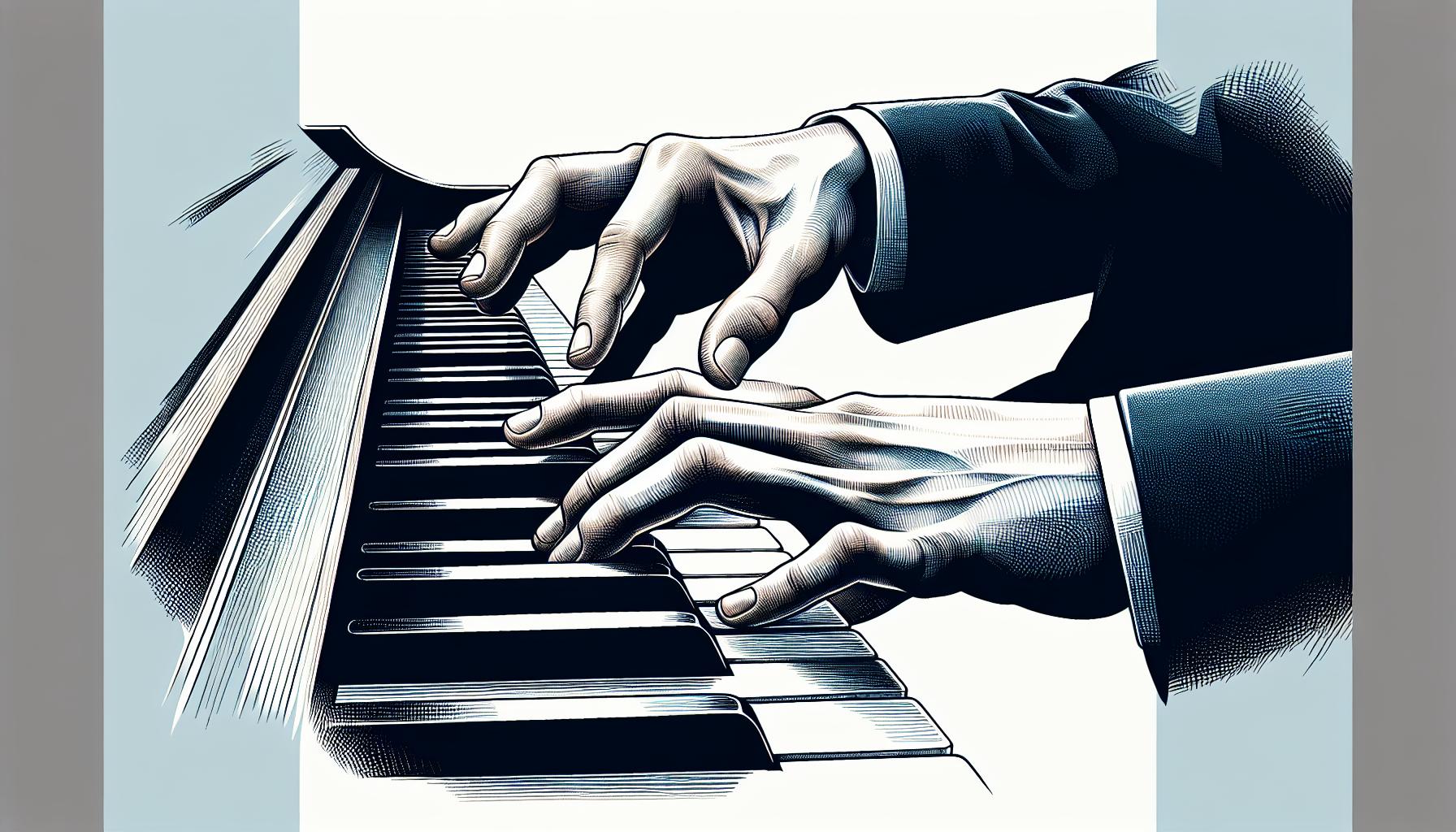Playing the piano should feel like a gentle conversation between your fingers and the keys, not a wrestling match. Yet, many pianists, both beginners and seasoned, find themselves battling tension. This not only hampers their ability to play fluidly but can also lead to discomfort and injury over time.
The good news is, with the right approach and techniques, anyone can learn to play the piano keys without tension. It's all about understanding how to position and move your body in a way that feels natural and effortless. In the journey to mastering relaxed piano playing, you'll not only enhance your performance but also enjoy the process a whole lot more.
Understanding the Importance of Relaxation in Piano Playing
When learning or mastering piano, one often hears about the critical role relaxation plays in both technique and expression. However, the significance of this concept goes beyond mere advice; it’s foundational to effective and enjoyable piano playing. At its core, relaxation in piano playing ensures that each motion is as efficient and natural as possible, eliminating undue strain on the muscles and joints.
The benefits of playing piano with a relaxed posture and technique are multifaceted. Firstly, it leads to improved accuracy and speed. Tense muscles have less control and slower reaction times, making precision difficult to achieve. In contrast, relaxed muscles respond more quickly and accurately, allowing for swift and precise movements across the keyboard.
Moreover, relaxation is key to enhancing musical expression. Music, in essence, is about conveying emotions, and tension can impede this communication. A relaxed pianist can more easily modulate touch, dynamics, and tempo, breathing life into the music and connecting deeply with the audience.
Injury prevention is another significant advantage of relaxation. Repetitive strain injuries, such as tendonitis and carpal tunnel syndrome, are common among pianists who practice with tension. By adopting a relaxed approach, one greatly reduces the risk of these debilitating conditions, ensuring a longer and more enjoyable playing career.
Adopting a Relaxed Playing Technique
Achieving relaxation while playing the piano involves both physical and mental adjustments. Physically, it starts with proper posture and hand position. Sitting at the right height and distance from the keyboard allows one to reach all the keys without stretching or straining. The hands should be poised above the keys with natural curves in the fingers, ready to play without stiffness.
Breathing plays a pivotal role in relaxation. Deep, regular breaths can help release tension throughout the body, especially in the shoulders and arms. Players should be mindful of their breathing patterns, ensuring they don’t hold their breath during challenging passages.
Mentally, relaxation entails a focus on the music rather than on the mechanics of playing. This shift in focus encourages a more intuitive interaction with the piano, where movements feel guided by the flow of the music rather than conscious effort.
- Weight Transfer Exercises: These help pianists understand how to use their arm weight effectively,
Proper Hand Positioning for Tension-Free Playing

Achieving a relaxed state while playing the piano hinges significantly on how pianists position their hands. It's a foundational aspect that, if done right, paves the way for effortless and expressive performances. Each finger should be poised and ready to strike the keys with precision, yet without the strain that often leads to fatigue or injury.
One primary rule for tension-free playing is ensuring the wrists remain flexible and slightly elevated. This positioning allows for a better flow of movement across the keyboard. Imagine there's a slight bubble under each wrist, encouraging a natural curve. Hands should float above the keys, with fingers curving gently, as if cradling an imaginary ball. This not only promotes agility and speed but also reduces the risk of cramping and the occurrence of repetitive strain injuries.
Equally important is the alignment of fingers. They should neither be too stretched out nor too cramped. Each fingertip must find its place on the keys with confidence and ease. Developing this level of comfort and efficiency might take time and practice, but the rewards in terms of improved accuracy and expression are well worth the effort.
Key Techniques for Mastery
Mastering tension-free playing involves a few key techniques that every pianist should practice:
- Thumb Under Technique: When transitioning between scales or reaching for notes, the thumb plays a crucial role. It should glide smoothly under the fingers to maintain a seamless flow of music without introducing strain.
- Weight Transfer: Effective use of arm weight, rather than relying solely on finger strength, is essential. This technique involves allowing the arm's natural weight to press the keys through relaxed fingers, minimizing effort and maximizing sound quality.
- Rotation: Slight rotational movements of the forearm can help in easing the passage of fingers over the keys, particularly during complex pieces. This motion aids in distributing tension evenly, preventing overuse of any single muscle group.
Engaging in regular exercises that focus on these techniques can greatly enhance a pianist's ability to play without tension. Incorporating slow, mindful practice sessions where attention is given to hand positioning and movement helps in developing a more relaxed approach to playing. Additionally, it's beneficial to periodically assess one's posture and hand alignment, making adjustments as needed to ensure optimal positioning.
Techniques to Release Tension while Playing Piano Keys

Unlocking the secrets to tension-free piano playing is crucial for both beginners and seasoned pianists. It's not just about how one sits at the piano or the way hands dance across the keys; it's about integrating techniques that ensure every note is played effortlessly. Here are a few methods that help release tension while playing.
Breathing Techniques often go unnoticed but play a pivotal role in managing tension. Deep, controlled breathing calms the mind, which in turn relaxes the muscles. A pianist should practice inhaling deeply before starting to play and maintain steady breathing through their practice. This approach not only reduces stress but also improves concentration.
Incorporating Stretching and Warm-up Exercises before playing is another effective strategy. Stretching the fingers, wrists, and arms helps loosen the muscles, making them more flexible and reducing the risk of injuries. Warm-up exercises like scales or simple arpeggios prepare the hands for more complex pieces, allowing for smoother transitions between notes.
Mindfulness and Mental Imagery are powerful tools for alleviating tension. Visualizing the hands moving effortlessly on the keys or imagining playing with a relaxed posture can influence physical reality. Being mindful of one’s thoughts and physically relaxing any tightened muscle spotted during playing helps maintain a relaxed state.
Adopting the Alexander Technique, which emphasizes efficient movement and posture, can significantly aid pianists. This method encourages awareness of the body and its movements, promoting ease and fluidity. It helps identify harmful habits that cause tension and offers practical ways of eliminating them.
Finally, the principle of Regular Breaks cannot be overstated. It's tempting to practice for hours on end, but without sufficient rest, muscles don’t have time to recover, leading to accumulated tension. Taking short breaks every 20-30 minutes allows the body to reset, preventing the buildup of fatigue and stress.
Each of these techniques offers a pathway toward achieving ease and efficiency in piano playing. By incorporating them into one’s daily practice regime, pianists can look forward to hours of joyful, tension-free playing. Practicing these strategies consistently will not only enhance performance but also prolong one’s musical career by minimizing the risk of injuries associated with undue tension.
Building Relaxation into Your Practice Routine

Integrating relaxation techniques into a pianist’s practice routine is crucial for playing without tension. When musicians prioritize relaxation, they can significantly enhance their performance and prevent injury.
One effective way to ensure relaxation is to start every practice session with deep breathing exercises. Deep breaths help calm the nervous system, reduce stress, and prepare the body for a session of focused practice. Pianists should take a few moments to sit comfortably at the piano, close their eyes, and breathe deeply, focusing on filling and emptying their lungs slowly.
After setting a calm foundation with breathing, stretching exercises aimed at the fingers, hands, wrists, and shoulders are next. Gentle stretching can prevent stiffness and increase flexibility, crucial for fluid playing. Stretches should be done slowly and with care to avoid any strain.
Warm-up exercises specifically tailored to piano playing are also essential. Scales, arpeggios, and simple pieces allow the hands and mind to ease into the practice session. These should be played slowly, with attention to maintaining a loose wrist and a relaxed grip on the keys.
Incorporating mindfulness into practice can significantly impact one's ability to play without tension. Being fully present and aware of every note, the touch of the keys, and the movement of the hands helps pianists identify and release unnecessary tension. Tools such as mental imagery, where musicians visualize playing with ease and flow, can also be beneficial.
The Alexander Technique, focusing on improving posture and eliminating harmful habits, offers valuable insights for pianists. It teaches the importance of proper alignment and balance, ensuring that pianists adopt positions that do not contribute to tension.
Finally, regular breaks during practice sessions are crucial. They should not be seen as interruptions but as an integral part of the routine that allows the body and mind to rest. Pianists can use this time to reflect on their practice, assess any areas of tension, and perform light stretches.
By integrating these relaxation techniques into their practice routine, pianists create a foundation for tension-free playing. It's not just about the time spent at the piano but how they approach their practice mentally and physically. With consistency, these methods lead to a more relaxed, efficient practice that's both enjoyable and productive.
Benefits of Playing Piano Keys without Tension

Playing piano keys without tension doesn’t just make the experience more enjoyable; it offers a plethora of benefits that can significantly enhance a pianist's performance and overall well-being. One of the most immediate impacts is improved sound quality. When they're relaxed, pianists can control their touch and dynamics more effectively, producing a sound that is both rich and expressive. This level of control is difficult, if not impossible, to achieve when muscles are tight.
Another significant advantage is increased endurance and speed. Tension restricts movement, making fast passages and long playing sessions more challenging. By playing relaxed, pianists can move more freely, allowing for quicker finger action and reduced fatigue. This is crucial for pieces that require stamina and agility.
Here's a brief overview of the key benefits:
- Improved sound quality
- Increased endurance and speed
- Less risk of injury
- Enhanced learning and memorization
Playing without tension also greatly reduces the risk of injury. Tension-related injuries, such as tendinitis or carpal tunnel syndrome, can sideline a pianist for weeks or even months. Relaxation techniques not only prevent such injuries but also promote a quicker recovery should any discomfort arise.
Furthermore, pianists who practice relaxation report enhanced learning and memorization abilities. Tension can hinder the brain's ability to form new connections, slowing down the learning process. A relaxed state, on the other hand, facilitates cognitive functions, making it easier to memorize music and understand complex pieces.
Incorporating relaxation into practice sessions transforms them from potentially stressful tasks into opportunities for growth and enjoyment. As pianists become more adept at maintaining a relaxed state, they'll find their practice sessions to be more effective and fulfilling. This shift not only benefits their musical journey but also contributes to their overall mental health by lowering stress levels and promoting a positive attitude toward practice.
Regular Implementation of Relaxation Techniques is critical for these benefits to materialize. Just as daily practice is essential for mastering the piano, consistent use of relaxation techniques is necessary for reaping the full rewards of tension-free playing. It's not something that can be achieved overnight but with persistence and mindfulness, pianists will notice significant improvements in both their playing and their approach to the instrument.
Conclusion
Mastering the art of playing piano keys without tension is a journey that offers numerous benefits. It's not just about producing beautiful music but also about caring for one's physical and mental well-being. By embracing relaxation techniques, pianists can enjoy improved sound quality, greater endurance, and a safer, more rewarding practice environment. Remember, consistency is key. Incorporating these methods into every practice session transforms the experience, making it not only more effective but truly enjoyable. Here's to making every note resonate not just through the piano, but through a relaxed, healthy body and mind.
Harlan Kilstein began playing piano during covid with no piano background at all. He taught himself how to play learning what to do and what not to do.
Today he's an advanced intermediate player and can help you grow in your skills because he learned all this on his own.








